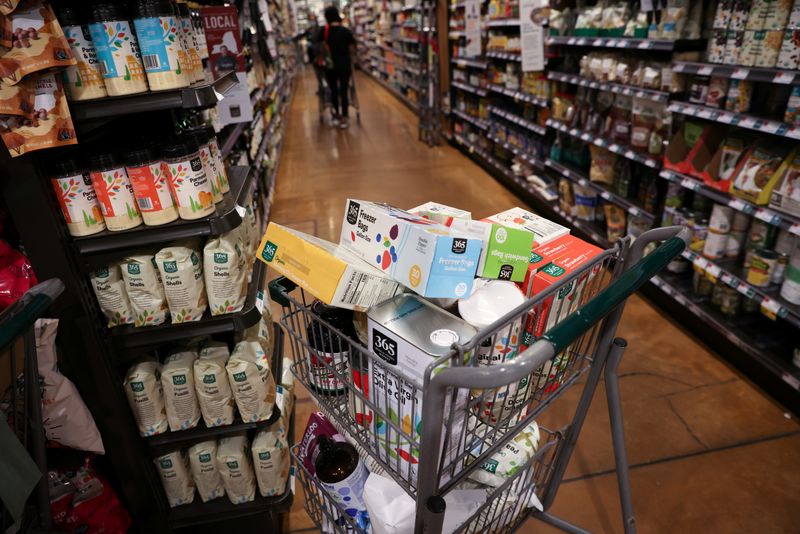By Lucia Mutikani
WASHINGTON (Reuters) - U.S. retail sales were unchanged in June as a drop in receipts at auto dealerships was offset by broad strength elsewhere, a display of consumer resilience that bolstered economic growth prospects for the second quarter.
The better-than-expected report from the Commerce Department on Tuesday also showed sales in May were higher than initially estimated. It did not change expectations that the Federal Reserve could start cutting interest rates in September amid cooling inflation and helped to assuage fears of a sharp slowdown in the economy.
"The economy is in pretty good shape," said Bill Adams, chief economist at Comerica (NYSE:CMA) Bank. "There are signs of softness around the edges where low- and moderate-income consumers are pulling back ... but openhanded spending by affluent consumers is keeping the economy as a whole moving forward."
The unchanged reading in retail sales last month followed an upwardly revised 0.3% gain in May, the Commerce Department's Census Bureau said.
Economists polled by Reuters had forecast retail sales, which are mostly goods and are not adjusted for inflation, would fall 0.3% after a previously reported 0.1% gain in May.
Retail sales increased 2.3% on a year-on-year basis in June. Momentum has, however, slowed from the 7.7% gain logged in January 2023. After a period of high inflation, households are trading down and seeking cheaper alternatives, as evident in earnings reports from major retailers and manufacturers.
PepsiCo (NASDAQ:PEP) CEO Ramon Laguarta said last week that lower-income consumers were "stretched" and "strategizing a lot to make their budgets get to the end of the month."
Online store sales jumped 1.9% last month, adding to a 1.1% increase in May. Sales at gasoline stations dropped 3.0%, reflecting lower prices at the pump. Cheaper gasoline is likely freeing money for other spending.
Building material and garden equipment store sales increased 1.4%. Sales at food services and drinking places, the only services component in the report, gained 0.3% after rising 0.4% in May. Economists view dining out as a key indicator of household finances.
Furniture store sales rose 0.6%. Receipts at electronics and appliance outlets advanced 0.4%, while those at clothing retailers increased 0.6%. Sales at sporting goods, hobby, musical instrument and book stores dipped 0.1%.
Receipts at motor vehicle and parts dealers declined 2.0%. A cyberattack at software systems provider CDK hit operations at several auto dealerships during the second half of June. Sales lost to the cyberattack are expected to be recouped in July.
A rise in the unemployment rate to a 2-1/2-year high of 4.1% in June sparked fears of a significant moderation in the economy, prompting financial markets to see a slight chance of the U.S. central bank starting its easing cycle this month.
Those July rate-cut bets were abandoned on Monday when Fed Chair Jerome Powell at an Economic Club of Washington event gave no indication that such a move was imminent.
Financial markets expect a rate cut in September followed by additional cuts in November and December. Stocks on Wall Street were trading largely higher. The dollar gained versus a basket of currencies. U.S. Treasury prices were mostly higher.
CONSUMERS FACE HURDLES
"This report doesn't negate expectations that the Fed will cut rates at its September 18 meeting, unless of course inflation-related data releases indicate an uptick in prices," said Quincy Krosby, chief global strategist at LPL Financial (NASDAQ:LPLA).
Inflation is likely to stay on a downward trend. Import prices were unchanged in June, a separate report from the Labor Department's Bureau of Labor Statistics showed.
The Fed has maintained its benchmark overnight interest rate in the current 5.25%-5.50% range since last July. It has hiked its policy rate by 525 basis points since 2022.
Retail sales excluding automobiles, gasoline, building materials and food services surged 0.9% last month after rising by an unrevised 0.4% in May. These so-called core retail sales correspond most closely with the consumer spending component of gross domestic product.
Economists now estimate that consumer spending, which accounts for more than two-thirds of the economy, grew at a 2.0% annualized rate in the second quarter. They had previously forecast consumer spending would match the first quarter's 1.5% rate. The strong performance in core retail sales sets consumer spending on a higher growth path heading into the third quarter.
Growth prospects for the second quarter also got a lift from a separate report from the Census Bureau showing business inventories rose 0.5% in May after climbing 0.3% in April.
The Atlanta Fed upgraded its GDP growth estimate for the second quarter to a 2.5% rate from a 2.0% pace. The economy grew at a 1.4% rate in the first quarter.
Still, hurdles remain for consumer spending. Most households have run down the excess savings accumulated during the COVID-19 pandemic and are carrying a lot of credit card debt, which is becoming more expensive because of higher borrowing costs.

Wage growth is slowing as the labor market eases.
"There are still growing signs that many consumers are reaching their max," said Ben Ayers, senior economist at Nationwide. "This is most pronounced among lower-income households which are most sensitive to increases in everyday costs and most at risk for a cutback in hiring."